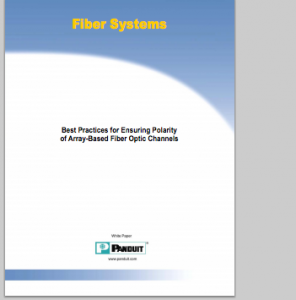Panduit’s Best Practices for Ensuring Polarity of Array-Based Fiber Optic Channels white paper describes recently published industry guidelines that address polarity across array-based fiber systems, and discusses the advantages and drawbacks of the three TIA/EIA recommended methods.
Excerpt:
Data centers are the central location for data interchange and are found in enterprises, government offices, schools, universities, hospitals, and other networked server farms. The ease of turning nearly any location into an information interchange hub has been enabled by the development of array-based fiber optic cabling systems. Ribbon fiber cables, array-based fiber connectors, and packaged breakout assemblies (i.e., cassettes) provide modular small form factor connectivity and enable fast, reliable interconnection of fiber optic links in high-density data center environments.
Once the decision has been made to deploy array-based fiber connectivity, care must be taken to ensure the integrity of connections between the transmitting optical light source and the receiving photo detector. The matching of the transmit signal (Tx) to the receive equipment (Rx) at both ends of the fiber optic link is referred to as polarity. The objective of polarity is simple: provide transmit-to-receive connections across the entire fiber optic system in a…>>Read More

